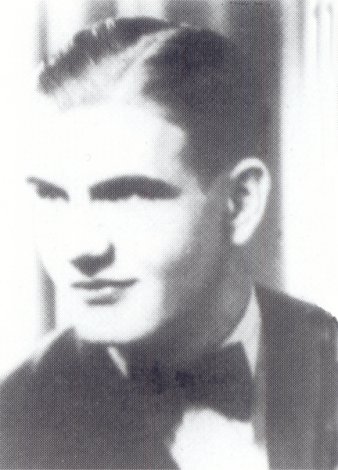
Stanislaw Sieradzki ,
born on September 14, 1921 in Ilowo near Dzialdowo
Home Army sergeant Cadet a.k.a. "Swist" ("Whistle")
Home Army union "Radoslaw"
section "Felek" company "Rudy" battalion "Zoska"
The Witnesses' Uprising Report
My meetings with "Morro"

Stanislaw Sieradzki ,
born on September 14, 1921 in Ilowo near Dzialdowo
Home Army sergeant Cadet a.k.a. "Swist" ("Whistle")
Home Army union "Radoslaw"
section "Felek" company "Rudy" battalion "Zoska"
For the first time I met Andrzej Romocki "Morro" at the end of the year 1943. We had an assembly in the atttic of a building in the Zelazna street at the corner of the Srebrna street, and I was late. There was a raid on my way and the Germans expelled all the people from the tram. While reporting myself at this assembly, I was told by the team commander Jurek Zakrzewski,
- "It's not good, "Swist", that you are late for the assembly. A scout should always be on time."
At that point I started to defend myself and told that the Germans had expelled me from the tram by the Kierbedzia bridge (now it's called the Slasko-Dabrowski bridge), had controlled me and let me go only because I had a card confirming my employment, and other people had been arrested. These were the reasons for my being late. And then Witek Morawski, our friend, who had his left arm in a sling, came forward and said,
- "Why are you excusing so much "Swist"? You've been late. Admit it. You knew that you were going to be late."
- "I won't be late anymore!" - I replied.
Peering at me, he said,
- "Moreover, you are not shaved."
And I only had some dots. I was only a young boy. My beard has just started to grow.
- "Unshaved - at the assembly" - he pointed once again.
And then I turned out to be an ill-mannered boy. I had a look at him and said,
- "A companion "Czarny" is also unshaved and what a nice beard he has."
I was impolite. I behaved like a boor. I remember that it was the time after an armed action, because Witold appeared at our Grey Regiments' assembly with a plaster dressing on his chest. His arm was put on a plaster platform due to a wound and a clavicle failure. Now I know that Witold was wounded in a "Wilanow" action, the first one of "Zoska" battalion, transformer a little time before from the Warsaw Assault Groups of the Grey Regiments. How could he be shaved? And how could I say something like that to such a person?: "A companion "Czarny" is also unshaved."
And then "Czarny" ordered me to report myself to command for a penalty.
My indelicacy became a direct reason for a conversation with the company commander, about which I was informed later on, in the summer of 1944, when the same commander was inspecting a training installation in the forests near Myszkow village, where I was staying in "Alek" and "Felek" sections from May till the end of July 1944.
My conversation with the company commander was arranged in the area of the Aviators' Monument in the Independence Avenue (Aleja Niepodleglosci).
In my hand I had some rolled colourful magazine, according to previously given instructions. The same roll was to be kept by someone waiting for me. So, I was waiting by this monument and suddenly saw a person reaching me, with a roll in his hand. I showed him mine. He rushed in the direction of the Mokotowskie Fields (Pola Mokotowskie). I followed him. When he went slower, I approached him. We started a talk,
- "Swist" is reporting himself."
- "I've heard that you accused the commander of his not shaving?"
- "Yes, companion instructor. I behaved impolitely and I feel great remorse. I shouldn't have behaved like that as I knew that this instructor had his arm in a sling."
- "Lucky you that this is what you think. As a penalty you will make ten inscriptions offending the Germans and, simultaneously, supporting the Polish people. The inscriptions must be made on a route from the Mirowski Square to the Zawisza Square."
The penalty laid on me seemed to be not serious but certainly it was educative.
I know how to paint. The task was made. I liked painting in the male toilets the most. There used to be such toilets standing on pavements. They were round. One could go inside, his legs visible and something dripping, but a face and a head were hidden. Several were in some places in Warsaw many years after the war. I painted two such devices inside: a Hitler's head on a gallows, a string, Hitler's moustache, a fringe -- Hitler that is hung up. Whether or not Andrzej (I got to know much later that he was my interlocutor in the Mokotowskie Fields) checked that - I don't know.
Andrzej Romocki, was born in Warsaw on April 16,1923, as a son of Pawel and Jadwiga (mother's maiden name Niklewicz). He was a bit younger than me.
Before the Second World War outbreak he was a pupil of the gymnasium and secondary school of the Mazovian Land Association. It was not possible for him to pass his exam for the certificate of secondary education in the period of the Independent Poland, that lasted after a long captivity, from 1918 till 1939.
Early, on June 28, 1940 Andrzej's father, who was his great friend, was killed by a German car. Andrzej was left with his mother and a younger brother Janek, born on April 17, 1925. This heart-breaking loss was not any obstacle in continuing Andrzej's education. He passed his Matura in the year 1941, and one has to remember that at the time he was a leader of the Mokotow district area of a self-training organisation "PET", a name meaning "past" in the Greek language. These people, similarly to the Zoliborz district area of "PET", later on joined the clandestine male scouting, hidden under the pseudonym "Grey Regiments." Starting from the year 1942 Andrzej Romocki, who used a pseudonym "MORRO", was a foreman In a "SAD" troops in Mokotow. His brother, Janek Romocki a.k.a. "Bonawentura", was in the same troops, as well.
At the end of the year 1943 Andrzej "Morro", as an outstanding and talented foreman, having passed a "baptism of fire" in a "Sieczychy action", commanded by him on August 21, 1943, was designated a commander of the second company "Rudy" in a just created Grey Geminents' battalion "Zoska". The cryptonym of the battalion was a pseudonym of Tadeusz Zawadzki, the commander of the Warsaw Assault Groups, killed in Sieczychy. "Morro" was a commander till the moment of his soldier death on September 15, 1944, during the Warsaw Uprising.
The end of June 1944 was the time of my second meeting with Andrzej "Morro". I was then with my "Felek" section in Wyszkow forests. We were training and were being prepared for the Grey Regiments' "Tomorrow", i.e. open fight with the German occupant. The commander of the "Rudy" company, "Andrzej Morro" was inspecting our guerrilla unit, because he wanted to check personally, to what "Giewont" - scoutmaster Miroslaw Cieplak, had led us, the Grey Regiments' people, in these hard forests conditions.
The aims of the training base (given by the battalion's commands) organised (not only) in the Wyszkow forests were as follows:
a) natural selection of people based on their behaviour in hard conditions,
b) examination of fortitude and mental disposal of people being in permanent and long-lasting danger,
c) creation of fraternal bonds in the conditions of discomfort, cold and hunger,
d) making particular people face the difficulties they had never faced before, and that will experience in a soldier life,
e) inspection of previous training, supplement of shortages (first of all in a practical sense) and - for some people - beginning of training at the higher level.
I find my talk with "Andrzej Morro", in the forests near Myszkow, very pleasant. I showed Andrzej a soviet machine gun "Pepesza" which I won over German deserters. He was looking at my handling by munition, and then he patted me on the shoulder in a friendly way. This forest talk with "Andrzej Morro" was a positive one for me also because of the fact that, after my coming back to Warsaw, in his order number 44/44 from July 11, 1944 Andrzej stated:
- "I proposed a promotion of Corporal "Świst" from the third section for a higher rank, for a good attitude and good examination results in the base".
I spent the whole July 1944 with my "Felek" section of the second company "Rudy". Just before the end of this base on July 26-27 Andrzej "Morro" went to us, to the forest. And then I got to know officially that he was my company commander Andrzej "Morro". I did not know his surname at the time. I knew Andrzej. I didn't know Romocki. I remember that at the time a decision was made to disband this unit and come back to Warsaw. Another decision was made, too. Three volunteers were to carry weapons belonging to this unit to Warsaw, for the Warsaw Uprising. There were 60 boys, so there were many weapons. We felt that the Rising would outbreak. Janek "Anoda" had a radio in which we heard Soviet appeals,
- "Reach the weapons!"
I remember a morning assembly. Andrzej "Morro" moved forward and shouted to us, standing in a row.
- "Three volunteers who have a good command of German - preside!"
I was the first. Janek Babinski, my friend, thanks to whom I joined the Grey Regiments, presided as the second and the third was Janek Rodowicz. I was totally surprised by this Janek's deed because, as I remembered, he did not know the German language well. He knew some short answers and he could utter in a perfect way this,
- "Jawohl, Herr Leutenant. Ich bin da" (Yes, sir. I am here.)
Such expressions - undoubtedly, but I wondered if he could reply anything in a conversation.
So we presided and then Andrzej "Morro" told us that we would get three German uniforms and a cart, by means of which we would carry the weapons in the area of Warsaw. We were to reach Wesola town, a supply place of our battalion commander Ryszard Bialous "Jerzy". We carried out this task luckily. Of course we behaved as instructed - to avoid main roads and places where the Germans could be. All of us were wearing German uniforms. When some countryman appeared in a field, we were speaking German. Otherwise, he could have said too much in the area. And we carried these weapons to Warsaw.
The Warsaw Uprising, August 6 or 7, the Wola district. Under the commandment of Janek "Anoda" we were storming, from the Jewish Cemetery, the German posts in the streets: Soltyka, Ostroroga and Obozowa. We were displacing the Germans.
And there, in one of the buildings in the Mlynarska street number 53, on my left, I saw three Germans by a machine gun. They were shooting at the direction of Wola, a today department store Wola, trying to force back the attack of the squads commanded by "Slon" and "Kieros". I was looking at them from a gate. I made a decision immediately and threw three grenades. Two Germans escaped and one was wounded. He was lying, not able to move. After a second I rushed to this gun. It was a French Hotchis standing on a tripod, a very heavy one. I brought it to my court in the Mlynarska number 66. I wanted to shoot and put a barrel on a wall. I touched a trigger but heard no shots. Sitting by this machine gun, sad, I suddenly heard,
- "Get up, get up. I can see what's going on."
Having got up, I looked backwards and I saw a man who had ordered me to paint . It was my company commander Andrzej "Morro". I stood at attention.
- "I'm reporting myself - I've got the machine gun."
- "Well done. Can't you see that you've destroyed a part of the trigger by a grenade?"
It was true.
- "You will go with it to a gunsmith in the Okopowa street, to the school, and it is going to shoot afterwards."
- "Yes, sir, companion instructor!"
And he approached me and patted at my shoulder.
- "Swist", tell me, why you are such a man. You could be impolite for your commanders.
- "When? Where? I have always been a good pupil, a good scout and a good friend."
- "True but you were talking nonsense about Witold "Czarny" being unshaved."
- "Companion, can you remember such things during the Rising?"
- "Because I see that you were impolite then and now you can be so courageous. Thank you. Bye."
Andrzej was very even-tempered. I rarely could see him smiling. He was always contemplative. I particularly remember a day when I was wounded nearby the Polonia stadium, on August 22. I was cut by five pieces from an armour-piercing gun. I was brought to an insurgent hospital in the Mlawska street. Andrzej "Morro" visited me there. He did it like a good protector, like my commander. I will not forget his sad face till the end of my life.
During fights in the Old Town Andrzej "Morro" experienced his personal tragedy - the death of his younger brother Janek "Bonawentura".
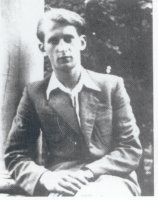
Janek Morro a.k.a. "Bonawentura"
My wounded friend, lying in a hospital in the Miodowa street number 23, wanted to boast that a great poet was situated next to him. Someone in the hospital found Janek's poems.
- "Swist", you've got no idea next to whom I'm lying."
And then I saw Janek whom I had not known before. He was in the first section, and I was in the third. The first section joined us, the third section "Felek", in fights only once. They were conquering the buildings in the Wola district, where I got a machine gun. When I stood by a bed on which Janek "Bonawentura" was lying, I could not believe from the very beginning, that we could survive. Poor Janek, with his stomach wounded, with his spine hurt. He was speaking just a little, sad and poor. Then I got to know that my friend was coming back with me to the hospital named after Jan Bozy. I was to go to the hospital again on August 18, in the evening and I was told that the hospital had been bombarded. I was free then so I rushed there. The boys were lying on the second floor Both this floor and this building were simply non-existing. Everything had crushed. Nothing was left from the room where Janek "Bonawentura" and my friend Janek Zastawny were lying. Everything was crushed.
Andrzej "Morro" was passing across all that. He was fighting further on, commanding as bravely as never before. He must have hidden his own pain and despair while visiting our posts.
The last time I saw him in the Czerniakow district where we were preparing the Vistula coast for landing of the soldiers from the third division named after Romuald Traugutt. They were the soldiers of General Berling, from the army which came nearby Warsaw, accompanied by the Red Army. Our company "Rudy" under the command of Andrzej was given a task to prepare the coast and create conditions for these soldiers to land safely. They were to come on pontoon boats and wounded people were to go back by them to Saska Kepa district.
A tragic day in Czerniakow, September 15, 1944, came. We were defending our positions from the first days of September. Units of "Zoska" battalion, damaged after hard fights in the Old Town, arrived. Andrzej "Morro" - a hero of insurgent units coming from the Old Town to Srodmiescie district, by Saski Garden - was also with us. He was commanding his girls and boys, despite the fact that his face had been wounded during the way.
During the night between September 14 and 15, 1944 the sections of the company "Rudy" were moved from the streets Rozbrat and Szara to the Vistula shore. I was in the section commanded by Jurek Gawin a.k.a. "Slon".
I will not forget our preparation for this Vistula cleaning. While coming from the streets: Rozbrat, Cecylii Sniegockiej and Szara and approaching the Vistula shore, we found ourselves in the court of a school in the Zagorna street. There Andrzej spoke to us, those who were able to move. To tell you the truth, I could not use my right hand at the time, as I had plaster on it, but the boys took me from the hospital in Srodmiescie. I went there with them and I remember how softly Andrzej spoke to us, that we were waiting for help to land but we had to prepare peaceful conditions by the Vistula river for these soldiers. And then, reacting for his order, one section commanded by Jurek Gawin "Slon" was going in the Solec street, in the direction of the Poniatowski bridge, and the second section, commanded by Andrzej Samsonowicz "Ksiaze", was going on the river shore. And the latter disappeared. We don't know what happened with the boys. We happily reached the Wilanowska street.
I remember the moment when we were leasing the Zagorna street and going to the Vistula route. It is not proper to use such an expression, but the words uttered by Andrzej were for us words of a father who would let us go to the unknown, with a faith that we would do what our duty was.
So we did it. We prepared the place for this landing. The Vistula shore was to be safe for the landing of the soldiers of the First Army of the Polish Troops, who came from the East, from the Soviet Union. We were waiting for them as if they were salvation. Space from the Zagorna street to the Wilanowska street was cleaned. People standing at our posts were looking in the direction of the Vistula (where the Polish soldiers were said to be) as well as in the direction of the Poniatowski bridge where German posts were situated. We had to watch out for them because they would shoot us from the bridge.
Having seen from the other shore (Saska Kepa) the ones who had landed, and there were few of them, we called them in Polish and in Russian to come to us. "Andrzej Morro" appeared on a floor of the Wilanowska 1 building. Before, the girls had made a Polish flag out of a sheet and a red bed-cover. It was put on a level of the second floor , as invisible for the Germans, but visible for the soldiers coming from the Vistula river. Those who had landed, were taken in a kind of a trap and could not reach us. They, and we as well, were constantly under German fire from the Poniatowski bridge.
I remember myself being at the attic of the Wilanowska 1 building. From that attic, hidden by a chimney, I could see the Vistula, the Poniatowski bridge and our boys. Opposite this house there was a low house. I could see the boys who jumper to this house and I Heard a shout, "Everybody into this house". Then I ran downstairs, from the third floor, I think, and looked from the court of the Wilanowska 1 street in the direction of that low house. I saw Andrzej while rushing from the Solec street to that house. He was noticed from the Poniatowski bridge. I heard a shot, an accurate one. Andrzej was hit in the chest. The girls and the boys dragged him in this house. I jumped inside through the window. I will never forget his insurgent jacket, covered with blood. Is he alive? There were two nurses who were examining him and both said with resignation that Andrzej was dead. Enemy fire was still strong from the direction of the bridge. I was standing next to the dead body of Andrzej lying in a table. All the faces of people standing around were serious. Girls and boys set their teeth. There was total silence. All the heads leaned. A follow of Andrzej "Morro" - "Witold Czarny" was reporting,
- Andrzej "Morro" is dead. Contact with the other side of the Vistula has been established."
Andrzej was buried in a Holy Trinity church estate in the Solec 61 street.
On September 16, in the Wilanowska street number 7, I was wounded for the third time. In the cellars of the Wilanowska 1 house, where a hospital was situated, I was wounded as a balcony was crushed over me. I was lying next to Janek "Anoda". And we both were transported through the Vistula River by one of above-mentioned boats. Janek was brought to Otwock, to the hospital. He was seriously wounded. I, with those pieces and wounds, found myself in a hospital of Albertyni Convent in the Wiatraczna street in the Praga district. And there I firstly experienced meetings with so-called fraternal Red Army.
In autumn of the year 1945 those who were lucky to have survived could finish the exhumation of the dead bodies of the girls and boys who had died during the Warsaw Uprising Fighting Route of the Home Army Battalion "Zoska" - from Wola through Powazki, the Old Town and Czerniakow. Probably the last person being exhumated was Andrzej "Morro". His dead body lying in the Holy Trinity church estate in the Solec 61 street must have been unearthed In order to be within the previously exhumated and buried In the Powazki Military Cemetery in Warsaw.
I was among those who exhumated the dead body of Andrzej. Cautiously, with emotion, we were digging out a box made of planks in which the dead body of our beloved commander had been put. Next to the diggers Andrzej's mother was standing, calm, looking at the ground.
At last we fetched the box from a hole. A new, clean and oak coffin was standing nearby. We had to put the dead body of Andrzej into this coffin. We were doing it very slowly and cautiously. Suddenly, the body of Andrzej, destroyed by a yearly stay in the ground, started to come apart. Andrzej's head fell from my right hand on the ground.
"Boys, be careful" - the mother said. We were not able to do anything.
Then, the dead body of Andrzej "Morro", resting in a coffin, were brought to the Holy Trinity church. The next day (and it was in October 1945), we, the living soldiers of the Home Army Battalion "Zoska" , carried on our shoulders the coffin with the dead body of the commander, from Czerniakow to the Powazki Military Cemetery.
We were coming back with Andrzej, from Czerniakow, through the Old Town, in the direction of Wola, to Powazki. There, among hundreds of killed insurgents of the Home Army union "Radoslaw", between nurses, liaison officers and soldiers of the "Zoska" battalion, the dead body of the captain, scoutmaster Andrzej Romocki a.k.a. "Morro", the commander of the second company "Rudy" of the "Zoska" battalion, the man honoured with Silver Order of the Virtuti Militari Cross and twice - the Cross of the Brave, lied down in an A-20 quarter. Andrzej rests in the third row, close by a grave of Janek "Bonawentura", his younger brother.
He died at the age of 21.
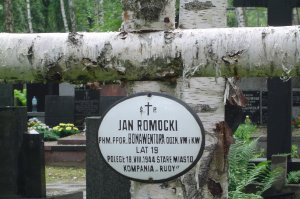
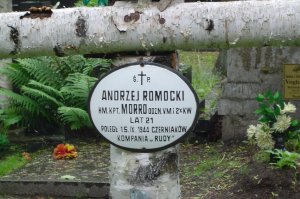
The graves of "Bonawentura" and "Morro"
For a long time I was a close friend of Mrs. Jadwiga Romocka, who had always welcomed me saying, "Sonny, sonny". She lived in the Mokotow district, by a Warszawianka stadium. The year 1975 came and Mrs. Romocka died. Recently my friends have called me. They found a grave of Mrs. Romocka. It turned out that she did not have any family and her abandoned grave was tumbling down. I've thought that in Warsaw there are scouting units named after Andrzej Romocki "Morro" and his mother is resting in such a grave. I can't understand it. When I recover I will appeal to these units so that they do something with a grave of the mother of "Zoska" battalion's heroes.
Stanislaw Sieradzki
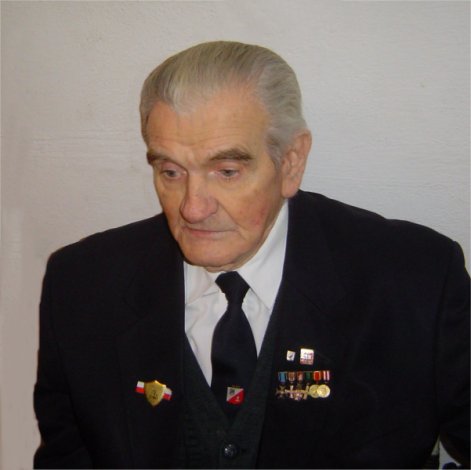
|
Stanislaw Sieradzki |
translation: Monika Alasa
Copyright © 2009 Maciej Janaszek-Seydlitz. All rights reserved.